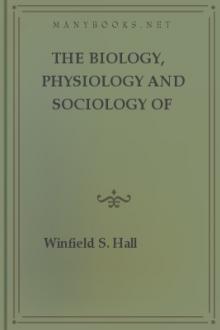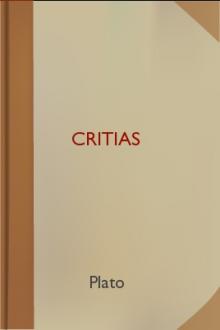Illusions, James Sully [speld decodable readers .TXT] 📗

- Author: James Sully
- Performer: -
Book online «Illusions, James Sully [speld decodable readers .TXT] 📗». Author James Sully
[5] Here and elsewhere I use the word "impression" for the whole complex of sensation which is present at the moment. It may, perhaps, not be unnecessary to add that, in employing this term, I am making no assumption about the independent existence of external objects.
[6] Psychological usage has now pretty well substituted the term "image" for "idea," in order to indicate an individual (as distinguished from a general) representation of a sensation or percept. It might, perhaps, be desirable to go further in this process of differentiating language, and to distinguish between a sensational image, e.g. the representation of a colour, and a perceptional image, as the representation of a coloured object. It may be well to add that, in speaking of a fusion of an image and a sensation, I do not mean that the former exists apart for a single instant. The term "fusion" is used figuratively to describe the union of the two sides or aspects of a complete percept.
[7] This impulse to fill in visual elements not actually present is strikingly illustrated in people's difficulty in recognizing the gap in the field of vision answering to the insensitive "blind" spot on the retina. (See Helmholtz, Physiologische Optik, p. 573, et seq.)
[8] This relation will be more fully discussed under the head of "Memory."
[9] I adopt this distinction from Dr. J. Hughlings Jackson. See his articles, "On Affections of Speech from Diseases of the Brain," in Brain, Nos. iii. and vii. The second stage might conveniently be named apperception, but for the special philosophical associations of the term: Problems of Life and Mind, third series, p. 107. This writer employs the word "preperception" to denote this effect of previous perception.
[10] Such verbal suggestion, moreover, acting through a sense-impression, has something of that vividness of effect which belongs to all excitation of mental images by external stimuli.
[11] See Wundt, Physiologische Psychologie, p. 723.
[12] For a confirmation of the view adopted in the text, see Professor Bain, The Senses and the Intellect, Part II. ch. i. sec. 8; Herbert Spencer, Principles of Psychology, vol. i. p. 234, et passim; Dr. Ferrier, The Functions of the Brain, p. 258, et seq.; Professor Wundt, op. cit., pp. 644, 645; G. H. Lowes, Problems of Life and Mind, vol. v. p. 445, et seq. For an opposite view, see Dr. Carpenter, Mental Physiology, fourth edit., p. 220, etc.; Dr. Maudsley, The Physiology of Mind, ch. v. p. 259, etc.
[13] See note, p. 22.
[14] Touch gives much by way of interpretation only when an individual object, for example a man's hat, is recognized by aid of this sense alone, in which case the perception distinctly involves the reproduction of a complete visual percept. I may add that the organ of smell comes next to that of hearing, with respect both to the range and definiteness of its simultaneous sensations, and to the amount of information furnished by these. A rough sense of distance as well as of direction is clearly obtainable by means of this organ. There seems to me no reason why an animal endowed with fine olfactory sensibility, and capable of an analytic separation of sense elements, should not gain a rough perception of an external order much more complete than our auditory perception, which is necessarily so fragmentary. This supposition appears, indeed, to be the necessary complement to the idea first broached, so far as I am aware, by Professor Croom Robertson, that to such animals, visual perception consists in a reference to a system of muscular feelings defined and bounded by strong olfactory sensations, rather than by tactual sensations as in our case.
[15] It may be said, perhaps, that the exceptional direction of attention, by giving an unusual intensity to the impression, causes us to exaggerate it just as in the case of a novel sensation. An effort of attention directed to any of our vague bodily sensations easily leads us to magnify its cause. A similar confusion may arise even in direct vision, when the objects are looked at in a dim light, through a want of proper accommodation. (See Sir D. Brewster, op. cit., letter i)
[16] They might also be distinguished as objective and subjective illusions, or as illusions a posteriori and illusions a priori.
[17] Die Schein-Bewegungen, von Professor Dr. J.I. Hoppe (1879); cf. an ingenious article on "Optical Illusions of Motion," by Professor Silvanus P. Thompson, in Brain, October, 1880. These illusions frequently involve the co-operation of some preconception or expectation. For example, the apparent movement of a train when we are watching it and expecting it to move, involves both an element of sense-impression and of imagination. It is possible that the illusion of table-turning rests on the same basis, the table-turner being unaware of the fact of exerting a certain amount of muscular force, and vividly expecting a movement of the object.
[18] Physiologische Optik, p. 316.
[19] It is plain that this supposed error could only be brought under our definition of illusion by extending the latter, so as to include sense-perceptions which are contradicted by reason employing idealized elements of sense-impression, which, as Lewes has shown (Problems of Life and Mind, i. p. 260), make up the "extra-sensible world" of science.
[20] An ingenious writer, M. Binet, has tried to prove that the fusion of homogeneous sensations, having little difference of local colour, is an illustration of this principle. (See the Revue Philosophique, September, 1880.)
[21] Even the fusion of elementary sensations of colour, on the hypothesis of Young and Helmholtz, in a seemingly simple sensation may be explained to some extent by these circumstances, more especially the identity of local interpretation.
[22] The perception of lustre as a single quality seems to illustrate a like error. There is good reason to suppose that this impression arises through, a difference of brightness in the two retinal images due to the regularly reflected light. And so when this inequality of retinal impression is imitated, as it may easily be by combining a black and a white surface in a stereoscope, we imagine that we are looking at one lustrous surface. (See Helmholtz, Physiologische Optik, p. 782, etc., and Populäre wissenschaftliche Vorträge, 2tes Heft, p. 80.)
[23] The conditions of the production of these double images have been accurately determined by Helmholtz, who shows that the coalescence of impressions takes place whenever the object is so situated in the field of vision as to make it practically necessary that it should be recognized as one.
[24] These illusions are, of course, due in part to inattention, since close critical scrutiny is often sufficient to dispel them. They are also largely promoted by a preconception that the event is going to happen in a particular way. But of this more further on. I may add that the late Professor Clifford has argued ingeniously against the idea of the world being a continuum, by extending this idea of the wheel of life. (See Lectures and Essays, i. p. 112, et seq.)
[25] It is supposed that in the case of every sense-organ there is always some minimum forces of stimulus at work, the effect of which on our consciousness is nil.
[26] See Helmholtz, Physiologische Optik, p. 603. Helmholtz's explanation is criticised by Dr. Hoppe, in the work already referred to (sec. vii), though I cannot see that his own theory of these movements is essentially different. The apparent movement of objects in vertigo, or giddiness, is probably due to the loss, through a physical cause, of the impressions made by the pressure of the fluid contents of the ear on the auditory fibres, by which the sense of equilibrium and of rotation is usually received. (See Ferrier, Functions of the Brain, pp. 60, 61.)
[27] I do not need here to go into the question whether, as Johannes Müller assumed, this is an original attribute of nerve-structure, or whether, as Wundt suggests, it is due simply to the fact that certain kinds of nervous fibre have, in the course of evolution, been slowly adapted to one kind of stimulus.
[28] I here refer to what is commonly supposed to be the vague innate difference of sensation according to the local origin, before this is rendered precise, and added to by experience and association.
[29] The illusory character of this simple mode of perception is seen best, perhaps, in the curious habit into which we fall of referring a sensation of contact or discomfort to the edge of the teeth, the hair, and the other insentient structures, and even to anything customarily attached to the sentient surface, as dress, a pen, graving tool, etc. On these curious illusions, see Lotze, Mikrokosmus, third edit., vol. ii. p. 202, etc.; Taine, De l'Intelligence, tom. ii. p. 83, et seq.
[30] Quoted by G.H. Lewes, Problems of Life and Mind, third series, p. 335. These illusions are supposed to involve an excitation of the nerve-fibres (whether sensory or motor) which run to the muscles and yield the so-called muscular sensations.
[31] It is brought out by Griesinger (loc. cit.) and the other writers on the pathology of illusion already quoted, that in the case of subjective sensations of touch, taste, and smell, no sharp line can be drawn between illusion and hallucination.
[32] For a fuller account of these pathological disturbances of sensibility, see Griesinger; also Dr. A. Mayer, Die Sinnestäuschungen.
[33] Helmholtz, op. cit., p. 600, et seq. These facts seem to point to the conclusion that at least some of the feelings by which we know that we are expending muscular energy are connected with the initial stage of the outgoing nervous process in the motor centres. In other pathological conditions the sense of weight by the muscles of the arms is similarly confused.
[34] Wundt (Physiologische Psychologie, p. 653) would exclude from illusions all those errors of sense-perception which have their foundation in the normal structure and function of the organs of sense. Thus, he would exclude the effects of colour-contrast, e.g. the apparent modification of two colours in, juxtaposition towards their common boundary, which probably arises (according to E. Hering) from some mutual influence of the temporary state of activity of adjacent retinal elements. To me, however, these appear to be illusions, since they may be brought under the head of wrong interpretations of sense-impressions. When we see a grey patch as rose-red, as though it were so independently of the action of the complementary light previously or simultaneously, that is to say, as though it would appear rose-red to an eye independently of this action, we surely misinterpret.
[35] Quoted by G.H. Lewes, loc. cit., p. 257.
[36] The subject of the perception of movement is too intricate to be dealt with fully here. I have only touched on it so far





Comments (0)